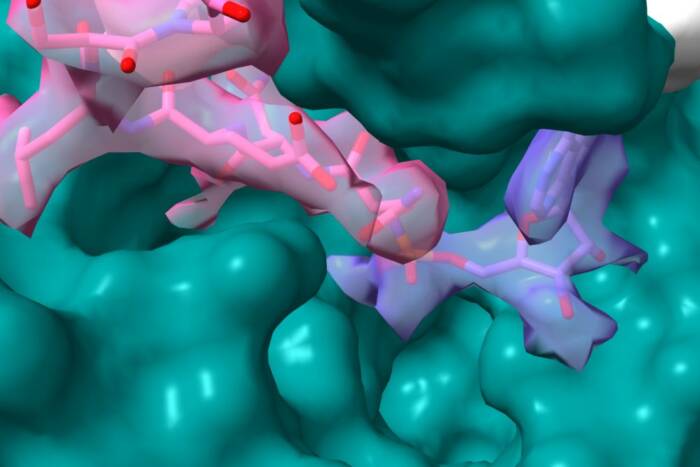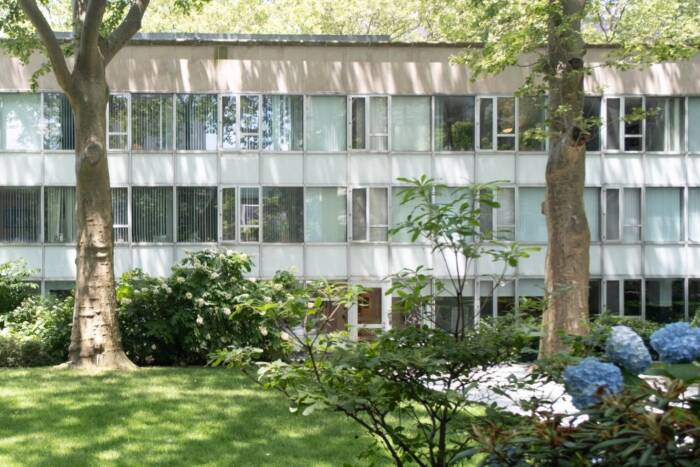Gairdner Prize honors Rockefeller scientist Ralph Steinman, M.D.
Dendritic cells, discovered at Rockefeller in 1973, now a vehicle for immune-based therapies

One of the first published images of dendritic cells from 1974 reveals the spiny surface of two of the sentinel cells next to a macrophage (left) binding with antigen-antibody complexes.
For the critical discovery of the immune system’s sentinel dendritic cells, and for demonstrating that science can fruitfully harness the power of these cells and other components of the immune system to curb infections and other communicable diseases, Professor Ralph Steinman, M.D., shares the 2003 Gairdner Foundation International Award, announced Tuesday, April 8, in Toronto.
The dendritic cell serves as the eyes and ears of the immune system. Many varieties of white blood cells known as lymphocytes contend with harmful microbes that can cause disease, as well as discriminate among good and bad environmental molecules at the body’s entry points and refrain, to a point, from attacking the body’s own tissues. Yet these white blood cells behave as if they are blind and deaf. They cannot easily sense the environment within which they live. The dendritic cell provides the link between the outside world and the body’s protectorate. Its specialties are capturing and processing potentially harmful materials and presenting those materials to the immune system’s other cells. Without the dendritic cell, the immune system would be just like a powerful machine without controls, or an operator to work them. With our growing knowledge of this specialized cell, clinical researchers are poised to greatly enhance their development of immune-based therapies.

The dendritic cell serves as the eyes and ears of the immune system, heralding the presence of antigens. Antigens come from microbes, such as parasites, viruses and bacteria, or the outside environment in the form of dust, gases, food or pollen, and finally, from our own cells.
Despite more than a century of precise medical knowledge of the immune system, modern researchers were introduced to the dendritic cell only 30 years ago. Rockefeller University’s Steinman is responsible for discovering the dendritic cell in 1973, with his colleague the late Zanvil Cohn.
Now in its 44th year, the Canadian Gairdner award, sponsored by the Gairdner Foundation, recognizes outstanding contributions by medical scientists whose work will significantly improve the quality of life. Informally known as a “Nobel Prize predictor,” the 264 past Gairdner awards have presaged 59 of Stockholm’s internationally coveted prizes.
In 2003, Rockefeller University’s Steinman shares the award with two other New York City scientists, neurobiologist Richard Axel and structural biologist Wayne A. Hendrickson, both of Columbia University, as well as Linda B. Buck of the Fred Hutchinson Cancer Center in Seattle, WA and Seiji Ogawa, Director of the Hamano Life Science Research Foundation of Tokyo, Japan. “The 2003 Gairdner Award winners have done elegant, provocative and essential work in neuroscience and immunology,” says John Dirks, President of the Gairdner Foundation. Each of the winners will accept their awards, which carry a value of $30,000, at a gala dinner in Toronto on October 23, 2003.
A system within a system

Rockefeller University's Ralph Steinman, M.D., discovered the dendritic cell in 1973 – a missing link to understanding the immune system's orchestrated response to antigens.
“To defend against disease, the body has many, many options,” says Steinman. “To exercise the options, the body relies on the dendritic cell; it is itself a system, not just a cell type.” In order to understand
how the dendritic cell, in its myriad locations and forms throughout the body, works as a guiding system of immunity, it is important to understand what an antigen is.
Antigens are the biochemical molecules that provoke immune responses in our bodies. They are the chemical flags, or signals, emitted by viruses, bacteria, parasites, fungi and other health-threatening microbes as they attempt to live and reproduce inside our bodies. Antigens also are found among the environmental proteins and enzymes – the dust, pollen, gases, foods and other chemical particles – that enter through our respiratory and digestive systems, and through our eyes, skin or any other tissue that comes in contact with the outside world. Finally, our bodies’ own tissues are the source of antigens. The dendritic cell coordinates the immune system’s response to the antigenic world, ensuring tolerance, or non-reactivity, to the harmless and immunity, or protection, to the harmful.
Cancer is a special instance in immunology. If cancer develops, the immune system can quell it. But the internal and surface chemistry of the cancer cell must first be recognized. Dendritic cells capture, process and present tumor cells to energize an anti-cancer response so that T cells can eradicate them.
There are millions of potential antigens. How do those powerful, but deaf and blind immune cells – the Ts, Bs and natural killer cells – function? Thanks to Steinman and now an entire field of immunologists studying dendritic cells, we have learned that lymphocytes follow the informed directives of dendritic cells.
Dendritic cells gather and wait for antigens to appear at all the body’s major traffic ways. These locations include the lymph nodes, liver and spleen, as well as air passages to the lungs, the corneas covering the pupils of our eyes and the lining of the digestive tract. Another type of dendritic cell called the Langerhans resides in large numbers at the skin’s surface.
Upon antigen sighting, the dendritic cell reads the antigen’s chemical signal and prepares to trumpet appropriate messages to other immune system cells. In many cases, the antigen is in one location and the lymphocytes needed to fight it are elsewhere, or passively dispersed throughout the body. Dendritic cells choreograph a communications link within the body. Capture of an antigen requires the multi-tasking dendritic cell to mature, or specialize, to deal with the antigen type that it found. Most of the dendritic cells gathered at important access points around the body are not yet fully developed, unable to express many of their specializations for mobilizing the immune system. Once they meet an antigen and capture it, two sorts of events must occur. One is to process and present antigen so the lymphocyte can recognize it. Another is to deliver additional “accessory” signals to the lymphocyte so that it becomes a helper or a killer. Maturation gives dendritic cells the chemical vocabulary with which to speak.
Next comes the challenge of how immune system cells find one another in the bodies’ vast internal terrain. Dendritic cells encourage B and T cells to respond to their antigen by describing what they’ve captured. In order to talk to the lymphocytes and show them their antigen, dendritic cells and lymphocytes must be in close proximity. “Lymphocytes literally percolate through the maze created by dendritic cells,” says Steinman. Once the Bs and Ts receive word of antigen via the dendritic cell, these lymphocytes act accordingly, reading the antigen’s shape and composition. B cells manufacture precise antibodies that tightly bind with antigen, tagging them like a condemned building marked for demolition. Immature T cells quickly transform themselves into tiny killing machines, targeting the antigens associated within infected cells, transplants and tumors.
Without the dendritic cell’s three phases of capturing, processing and presenting antigens, the immune system would remain largely deaf, blind — and mute.
Cellular extrovert delivers
Molecular biologists and geneticists have learned so much about the immune system that they are devising strategies to harness the immune system’s power, says Steinman. But the approach is slow-going, generally involving one targeted molecule at a time. “If we could learn to control the dendritic cell,” he adds, “it will bring dozens of molecules into the fray, and amplify our power to treat disease.” Dendritic cells amplify potential therapeutic strategies because they are cellular extroverts. They deal with harmful agents and orchestrate possible immune responses within the body. Their interactions are not with one specialized molecule or cell in the body, but with dozens appropriately tuned to an invader.
Now, in an experimental process known as ex vivo research, scientists at Rockefeller University and elsewhere are taking a patient’s own dendritic cells out of their body, multiplying them, exposing them to antigen or loading them with powerful drugs, and sending them back inside the body to deliver emphatic messages or finely tailored treatments. Because the dendritic cell forms the heart and soul of the immune system’s operations, it is capable of more precise control of immune mechanisms and better delivery than traditional treatments that send antigen or drugs randomly into the bloodstream. The dendritic cell as a sentinel of the body’s immune system makes it a potent therapeutic tool for researchers in many clinical settings.
“The dendritic cell controls hundreds of cells within the body,” says Steinman. “We must take advantage of this to improve human health.”
About Rockefeller University Professor Ralph Steinman
Ralph M. Steinman, M.D., Henry G. Kunkel Professor at The Rockefeller University and a senior physician at The Rockefeller University Hospital, heads the Laboratory of Cellular Physiology and Immunology at The Rockefeller University. Born in Montreal, Canada on January 14, 1943, Steinman received a B.S. degree, with honors, from McGill University in 1963, and an M.D., magna cum laude, from Harvard Medical School in 1968. After completing an internship and residency at Massachusetts General Hospital, he joined The Rockefeller University in 1970 as a postdoctoral fellow in the Laboratory of Cellular Physiology and Immunology jointly headed by the late Drs. Zanvil A. Cohn and James G. Hirsch. He was appointed an assistant professor in 1972, associate professor in 1976, and professor in 1988. He was named Henry G. Kunkel Professor in 1995, and director of the Christopher Browne Center for Immunology and Immune Diseases in 1998.
Steinman is editor of the Journal of Experimental Medicine and advisory editor of Human Immunology, theJournal of Clinical Immunology, the Journal of Immunologic Methods, International Immunology, and theProceedings of the National Academy of Sciences.
Steinman also is a trustee of the Trudeau Institute, in Saranac Lake, N.Y., and serves as a scientific advisor to several organizations including the Aaron Diamond AIDS Research Center, the AACR Cancer Immunology Task Force, the Charles A. Dana Foundation, a European consortium on the development of HIV vaccines, and the Canadian Vaccine Initiative in AIDS, Hepatitis and Cancer (CANVAC).
As an immunology pioneer, Steinman is member of the American Society of Clinical Investigation, the American Academy of Microbiologists, the American Society of Cell Biology, the American Association of Immunologists, the Harvey, Kunkel and Practitioner’s Societies, and the Society for Leukocyte Biology.
A recipient of the Freidrich-Sasse, Emil von Behring, and Robert Koch Prizes, Steinman also has received the Rudolf Virchow and Coley Medals. He has been awarded honorary degrees from the University of Innsburck and Free University of Brussels. He is a member of the National Academy of Sciences and its Institute of Medicine.


